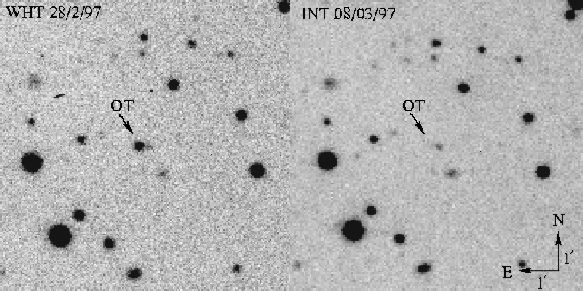Credit & Copyright: P. J. Groot (U. Amsterdam)
et al., WHT, INT
Explanation:
The largest telescopes in the world have scrambled
to point toward this faint, fading object.
Why? Because it may well be the first active optical counterpart
ever found for a gamma-ray burst,
and could hold the clue to the distance scale to this most
enigmatic class of astronomical objects.
During the past two months, multiwavelength observations,
claims,
and counterclaims
have been exchanged at a torrential pace, as astronomers wait impatiently
to see what setting houses the
fading transient.
Above are two pictures of the optical transient
(OT), one taken on February 28th, the other about a
week later on March 8th. The OT arrows show the source
that faded from view during this time.
The OT
has been examined by large telescopes including the Hubble
Space Telescope
and Keck, yet researchers are still scrambling
to get answers to fundamental questions about its true nature.
Does the OT
actually move (exhibit
proper motion)?
Is there a faint galaxy superposed behind
the OT or is this extended emission fading too?
In the face of intense scrutiny with the world's most capable telescopes,
the origin of gamma-ray bursts so far remains mysterious!
1999 2000 2001 2002 2003 2004 2005 2006 2007 2008 2009 2010 2011 2012 2013 2014 2015 2016 2017 2018 2019 2020 2021 2022 2023 2024 2025 |
Январь Февраль Март Апрель Май Июнь Июль Август Сентябрь Октябрь Ноябрь Декабрь |
NASA Web Site Statements, Warnings, and Disclaimers
NASA Official: Jay Norris. Specific rights apply.
A service of: LHEA at NASA / GSFC
& Michigan Tech. U.
|
Публикации с ключевыми словами:
оптическое послесвечение - гамма-всплески - космический телескоп им.Хаббла - Телескопы оптические
Публикации со словами: оптическое послесвечение - гамма-всплески - космический телескоп им.Хаббла - Телескопы оптические | |
См. также:
Все публикации на ту же тему >> | |
